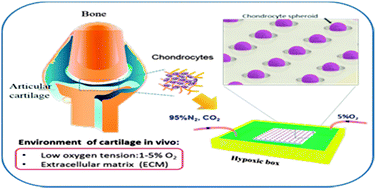Hypoxia combined with spheroid culture improves cartilage specific function in chondrocytes†
Abstract
Controlling the chondrocyte phenotype and function in a physiologically relevant microenvironment remains a major challenge for cartilage repair in tissue engineering applications. This work presents a straightforward strategy to create a high throughput concave microwell array used for generating multicellular spheroids of chondrocytes and facilitating the maintenance of the articular chondrocyte phenotype and function by combining 3D spheroid culture with hypoxia. The polydimethylsiloxane (PDMS) concave microwells were simply produced from a concave SU-8 template fabricated using a soft-lithography approach and easily adopted for size-controlled spheroid culture. 3D spheroid culture was observed to facilitate the cartilage-specific phenotype and function maintenance as compared to 2D monolayer culture. Combining hypoxia with spheroid culture markedly increased the expressions of cartilage-specific collagen II and aggrecan at protein and mRNA levels. The hypoxia-inducible factor (HIF) signaling pathway was found to get involved in phenotype maintenance, metabolism and differentiation of chondrocytes by regulating HIF-1α and HIF-2α, respectively. The established approach provides a useful platform for a wide range of applications in the field of cartilage biology, stem cell research and high throughput 3D drug testing in cancer.


 Please wait while we load your content...
Please wait while we load your content...